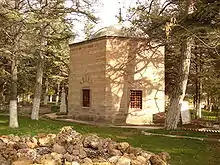Osman I
Osman I or Osman Ghazi (Ottoman Turkish: عثمان غازى, romanized: ʿOsmān Ġāzī; Turkish: I. Osman or Osman Gazi; died 1323/4),[1][3] sometimes transliterated archaically as Othman, was the leader of the Ottoman Turks and the founder of the Ottoman dynasty. The dynasty bearing his name later established and ruled the Ottoman Empire (first known as the Ottoman Beylik or Emirate). This state, while only a small Turkmen[6] principality during Osman's lifetime, transformed into a world empire in the centuries after his death.[7] It existed until shortly after the end of World War I.
| Osman I | |||||
|---|---|---|---|---|---|
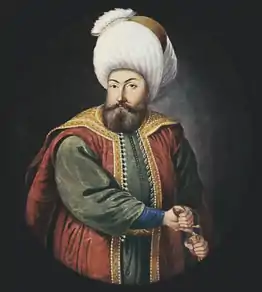 19th century panting showing Osman, by Konstantin Kapıdağlı | |||||
| Uç Bey of the Sultanate of Rum | |||||
| Reign | c. 1280 ‒ c. 1299 | ||||
| Predecessor | Ertuğrul | ||||
| Successor | Office disestablished | ||||
| 1st Sultan of the Ottoman Empire | |||||
| Reign | c. 1299 ‒ 1323/4 | ||||
| Predecessor | Office established | ||||
| Successor | Orhan | ||||
| Born | Unknown,[1] possibly c. 1254/5[2] Sultanate of Rum | ||||
| Died | 1323/4[3] (age 68-70) Bursa, Ottoman Beylik | ||||
| Burial | Tomb of Osman Gazi, Osmangazi, Bursa Province | ||||
| Spouse | Malhun Hatun Rabia Bala Hatun | ||||
| Issue | See below | ||||
| |||||
| ota | عثمان غازى | ||||
| tr | Osman Gazi | ||||
| Dynasty | Ottoman dynasty | ||||
| Father | Ertuğrul | ||||
| Mother | Unknown[5] | ||||
Owing to the scarcity of historical sources dating from his lifetime, very little factual information about Osman has survived. Not a single written source survives from Osman's reign.[8] The Ottomans did not record the history of Osman's life until the fifteenth century, more than a hundred years after his death.[9] Because of this, historians find it very challenging to differentiate between fact and myth in the many stories told about him.[10] One historian has even gone so far as to declare it impossible, describing the period of Osman's life as a "black hole".[11]
According to later Ottoman tradition, Osman's ancestors were descendants of the Kayı tribe of Oghuz Turks.[12] The Ottoman principality was one of many Anatolian beyliks that emerged in the second half of the thirteenth century. Situated in the region of Bithynia in the north of Asia Minor, Osman's principality found itself particularly well-placed to launch attacks on the vulnerable Byzantine Empire, which his descendants would eventually go on to conquer.
Name
Some scholars have argued that Osman's original name was Turkish, probably Atman or Ataman, and was only later changed to ʿOsmān, of Arabic origin. The earliest Byzantine sources, including Osman's contemporary George Pachymeres, spell his name as Ατουμάν (Atouman) or Ατμάν (Atman), whereas Greek sources regularly render both the Arabic form ʿUthmān and the Turkish version ʿOsmān with θ, τθ, or τσ. An early Arabic source mentioning him also writes ط rather than ث in one instance. Osman may thus have adopted the more prestigious Muslim name later in his life.[13] Arab scholars like Shihab al-Umari and Ibn Khaldun used the name Othman, while Ibn Battuta, who visited the region during Orhan I's reign, called him Osmancık (also spelled Othmānjiq or Osmanjiq).[14] The suffix -cık (or -cuk), indicates the diminutive in Turkish, thus he was known by the name of Osmancik, which means "Osman the Little", in order to differentiate between him and the third Caliph "Uthman the Great".[15]
Historical background
Most sources agree that the Ottoman Turks belonged to the Kayı Oghuz Turkic clan, who, according to Ottoman traditions, fled their native homeland in central Asia, during the early 13th century, due to the Mongol invasions. The clan settled in Anatolia, in a region belonging to the Seljuk Sultanate of Rûm.[16] Other sources claim that the Kayı clan moved to Anatolia two centuries earlier than the previously mentioned date, alongside the Seljuks, when they left Transoxiana to Khurasan around 1040 CE to reside near the city of Merv. Then, the Kayı clan moved towards eastern Anatolia after 1071 CE,[17] where it displaced alongside other Turkic clans. Later, it became involved in the army of Sultan Kayqubad I and fought against the Khwarizmians, Mongols and Byzantines, who were raiding Seljuk lands. According to several sources, the Kayı warriors were known for filling first lines in battles, and their fighting skills and bravery were among the major factors the Seljuks were victorious in many battles. This fact prompted Sultan Kayqubad to appoint Ertuğrul, the clan's Emir, as a Moqaddam (Lieutenant), and to reward the Kayıs some fertile lands near Ankara, where they settled and remained in the service of the Sultan for several years.[18][19]
Later, Ertuğrul was granted dominion over the town of Söğüt in northwestern Anatolia on the Byzantine frontier.[20] He also Obtained the title of Uç beyliği or Uç bey (literally: marcher-lord). Granting this title was in line with the traditions of the Seljuk Sultanate, which is rewarding any clan chieftain who rises to power and is joined by a number of smaller clans, the title of marcher-lord. However, Ertuğrul had far-reaching political ambitions. He sought to expand beyond the lands rewarded to him. Thus, he started raiding the Byzantine possessions in the name of the Sultan successfully conquering several towns and villages, and slowly expanding his dominion during the half of the century he spent as a Seljuk governor. In 680 AH / 1281 CE, Ertuğrul passed aways at nearly 90 years of age.[21]
Lineage
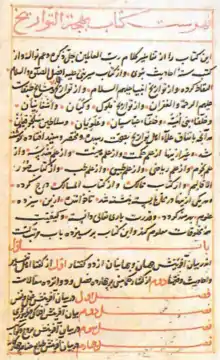
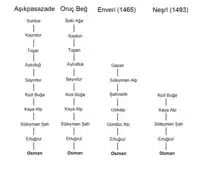
Although the exact date of Osman's birth is unspecified, some sources indicate that he was born on 8 Safar 656 AH / 13 February 1258 CE, the exact same day the Mongol hordes invaded Baghdad, killing its inhabitants and ravaging its landmarks.[22] Other Sources, such as 16th century Ottoman historian Kemalpaşazâde, says that Osman was most likely born around the middle of the 13th century, possibly in 1254/5 CE.[23] Information related to the early life of Osman is limited. However, the few available sources agree that he was born in the town of Söğüt, which his father Ertuğrul took as the capital of his emirate.[24] The reason for the lack of information available about this stage of Osman's life, is due to the fact that the oldest known source about this time period, was written about a hundred years after Osman's death.
Among these sources are: Destan-ı Tevarih-i Al-i Osman (the oral history of the Ottomans), written in the 14th century by the Ottoman poet and court physician Tâceddîn İbrâhîm bin Hızîr better known as Ahmedî (1334-1413 CE), Behcetü't Tevârîh (the joy of histories) by Şükrullah (d. 1464 CE), and Tevarih-i Âl-i Osman (history of the Ottomans) by Derviş Ahmed Âşıkî known as Âşıkpaşazâde (1400 - 1484 CE). ِAdditionally, these remaining sources are not the originals, but rather copies, or copies of the copies that were rewritten over the years, leading to a probable loss or altering in the information.[25] In fact, it is accepted that Ottoman, European, and Byzantine sources are not very reliable when considering the origins of Osman and his clan. On one hand, the oldest known records originally written by the Ottomans all date back to the period that followed the conquest of Constantinople (1453 CE). On the other hand, none of the Byzantine historians did refer in their writings to the origin of the Ottomans. As for European historians, these Turkic Muslim peoples were out of their interests. However, that changed after a century of this period, when the Ottomans began to pose a threat to Europe.[26]Ottoman historian Kemalpaşazâde mentioned that Osman was Ertuğrul's youngest son and that he was raised in the traditional nomadic Turkic ways: he learned wrestling, swordsmanship, horse riding, arrow shooting, and falconry, from an early age. He quickly mastered the previously mentioned skills outperforming all his brothers. He was also taught the principles of Islam, and was influenced by the teachings of Sufi Sheikhs, mostly his mentor Sheikh Edebali, and this was reflected in his personality and lifestyle.[27]

In terms of proportions, the most popular and classic narration is that Osman is the grandson of Süleyman Şah who died drowning while crossing the Euphrates River on horseback. Turkish historian Yılmaz Öztuna considers that Osman's Grandfather, and Ertuğrul's father, is called Gündüz Alp, saying that it is more likely that Süleyman Şah is a name stuck in Anatolian popular memory, and it actually refers to Süleyman bin Qutulmish who founded the Seljuk Sultanate of Rûm. Öztuna adds that it is possible that Ottoman historians tried forming a connection between the Ottomans and the Seljuks, especially since the Ottomans appeared on the stage of history claiming to be the legitimate successors of the Seljuks. Based on this, Osman's assumed lineage is as follows: Osman bin Ertuğrul bin Gündüz Alp bin Kaya Alp bin Gökalp bin Sarquk Alp bin Kayı Alp.[28] Other researchers agree that the connection between Ertuğrul, Osman, and the Seljuks, may have been largely invented by court chroniclers a century later, and the true origins of the Ottomans thus remain obscure.[29] On the other hand, some Ottoman sources indicate further lineage to Osman and the Oghuz Turks, which is closer to myth than reality, saying that these people are descendants of Japheth son of Noah and that Osman's genealogical tree contains 52 ancestors or more and ends with the Prophet Noah himself. This lineage includes Gökalp and Oghuz Han (which is said to be the father of Gökalp), and all the Oghuz Turkic peoples, including the Seljuks.[26] In this claim, one can notice the features of some of what Yılmaz Öztuna pointed out in his hypothesis, that the Ottomans were always trying to connect or relate themselves to the Seljuks, and to appear as their heirs.
Egyptian Mamluk historian, Muhammad Ibn Iyās, gave a totally different origin to Osman, in his six-volume book Badāʼiʻ az-zuhūr fī waqāʼiʻ ad-duhūr (Flowers in the Chronicles of the Ages). According to Ibn Iyās, Osman was of Arab origin, born in 658 AH (1259 - 1260 CE) in Hijaz, and he lived in Wadi As Safra' near the holy city of Medina. When economic crises struck the region due to the Mongol invasions, followed by a severe drought, Osman fled Hijaz and headed north to Anatolia and settled in Konya, capital of the Karamanid Beylik. As time went on, he got used to wearing Turkic clothing, followed Turkic customs and traditions, and learned to speak the Turkish tongue. Not long after that, he was in service to Emir Alâeddin Ali bin Khalīl, and became one of his most trusted men. Thus, Osman was rewarded with titles and land, which increased his power and was himself followed by many men.[30]
Origin of the Ottoman Empire
_-_Sultan_Osman_I._-_2242_-_Bavarian_State_Painting_Collections.jpg.webp)
The exact date of Osman's birth is unknown, and very little is known about his early life and origins due to the scarcity of sources and the many myths and legends which came to be told about him by the Ottomans in later centuries.[1][31] He was most likely born around the middle of the thirteenth century, possibly in 1254/5, the date given by the sixteenth-century Ottoman historian Kemalpaşazade.[2] According to Ottoman tradition, Osman's father Ertuğrul led the Turkic Kayı tribe west from Central Asia into Anatolia, fleeing the Mongol onslaught. He then pledged allegiance to the Sultan of the Anatolian Seljuks, who granted him dominion over the town of Söğüt on the Byzantine frontier.[32] This connection between Ertuğrul and the Seljuks, however, was largely invented by court chroniclers a century later, and the true origins of the Ottomans thus remain obscure.[33]
Osman became chief, or bey, upon his father’s death in c. 1280.[32] Nothing is known for certain about Osman's early activities, except that he controlled the region around the town of Söğüt and from there launched raids against the neighboring Byzantine Empire. The first datable event in Osman's life is the Battle of Bapheus in 1301 or 1302, in which he defeated a Byzantine force sent to counter him.[34]
Osman appears to have followed the strategy of increasing his territories at the expense of the Byzantines while avoiding conflict with his more powerful Turkish neighbors.[32] His first advances were through the passes which lead from the barren areas of northern Phrygia near modern Eskişehir into the more fertile plains of Bithynia; according to Stanford Shaw, these conquests were achieved against the local Byzantine nobles, "some of whom were defeated in battle, others being absorbed peacefully by purchase contracts, marriage contracts, and the like."[35]
Osman's Dream
Osman I had a close relationship with a local religious leader of dervishes named Sheikh Edebali, whose daughter he married. A story emerged among later Ottoman writers to explain the relationship between the two men, in which Osman had a dream while staying in the Sheikh's house.[36] The story appears in the late fifteenth-century chronicle of Aşıkpaşazade as follows:
He saw that a moon arose from the holy man's breast and came to sink in his own breast. A tree then sprouted from his navel and its shade compassed the world. Beneath this shade there were mountains, and streams flowed forth from the foot of each mountain. Some people drank from these running waters, others watered gardens, while yet others caused fountains to flow. When Osman awoke he told the story to the holy man, who said 'Osman, my son, congratulations, for God has given the imperial office to you and your descendants and my daughter Malhun shall be your wife.[37]
The dream became an important foundational myth for the empire, imbuing the House of Osman with God-given authority over the earth and providing its fifteenth-century audience with an explanation for Ottoman success.[38] The dream story may also have served as a form of compact: just as God promised to provide Osman and his descendants with sovereignty, it was also implicit that it was the duty of Osman to provide his subjects with prosperity.[39]
Military victories
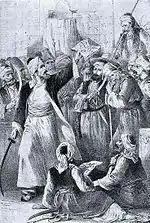
Until the end of thirteenth century, Osman I's conquests include the areas of Bilecik (Belokomis), Yenişehir (Melangeia), İnegöl (Angelokomis) and Yarhisar (Köprühisar), and Byzantine castles in these areas.[40][41][42]
According to Shaw, Osman's first real conquests followed the collapse of Seljuk authority when he was able to occupy the fortresses of Kulucahisar and Eskişehir. Then he captured the first significant city in his territories, Yenişehir, which became the Ottoman capital.[35]
In 1302, after soundly defeating a Byzantine force near Nicaea, Osman began settling his forces closer to Byzantine controlled areas.[43]
Alarmed by Osman's growing influence, the Byzantines gradually fled the Anatolian countryside. Byzantine leadership attempted to contain Ottoman expansion, but their efforts were poorly organized and ineffectual. Meanwhile, Osman spent the remainder of his reign expanding his control in two directions, north along the course of the Sakarya River and southwest towards the Sea of Marmara, achieving his objectives by 1308.[35] That same year his followers participated in conquest of the Byzantine city of Ephesus near the Aegean Sea, thus capturing the last Byzantine city on the coast, although the city became part of the domain of the Emir of Aydin.[43]
Osman's last campaign was against the city of Bursa.[44] Although Osman did not physically participate in the battle, the victory at Bursa proved to be extremely vital for the Ottomans as the city served as a staging ground against the Byzantines in Constantinople, and as a newly adorned capital for Osman's son, Orhan. Ottoman tradition holds that Osman died just after the capture of Bursa, but some scholars have argued that his death should be placed in 1324, the year of Orhan's accession.[45]
Family
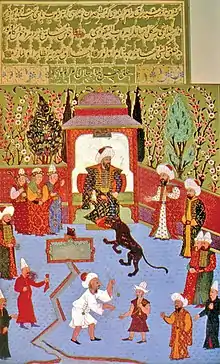
Due to the scarcity of sources about his life, very little is known about Osman's family relations. According to certain fifteenth-century Ottoman writers, Osman was descended from the Kayı branch of the Oghuz Turks, a claim which later became part of the official Ottoman genealogy and was eventually enshrined in the Turkish Nationalist historical tradition with the writings of M. F. Köprülü.[46] However, the claim to Kayı lineage does not appear in the earliest extant Ottoman genealogies. Thus many scholars of the early Ottomans regard it as a later fabrication meant to shore up dynastic legitimacy with regard to the empire's Turkish rivals in Anatolia.[12] Yazıcıoğlu Ali, in early 15th century, traced Osman's genealogy to Oghuz Khagan, the mythical ancestors of Western Turks, through his senior grandson of his senior son, so giving the Ottoman sultans primacy among Turkish monarchs.[47]
It is very difficult for historians to determine what is factual and what is legendary about the many stories the Ottomans told about Osman and his exploits, and the Ottoman sources do not always agree with each other.[48] According to one story, Osman had an uncle named Dündar with whom he had a quarrel early in his career. Osman wished to attack the local Christian lord of Bilecik, while Dündar opposed it, arguing that they already had enough enemies. Interpreting this as a challenge to his leadership position, Osman shot and killed his uncle with an arrow.[49] This story first appears in Neşri's work but is missing in earlier Ottoman historical works. If it was true, it means that it was likely covered up in order to avoid tarnishing the reputation of the Ottoman dynasty's founder with the murder of a family member. It may also indicate an important change in the relationship of the Ottomans with their neighbors, shifting from relatively peaceful accommodation to a more aggressive policy of conquest.[50]
Marriages
- Malhun Hatun, daughter of Ömer Abdülaziz Bey[51]
- Rabia Bala Hatun, daughter of Sheikh Edebali[51][52]
Sons
Daughter
- Fatma Hatun (buried in Söğüt)[55]
The Sword of Osman
The Sword of Osman (Turkish: Taklid-i Seyf) was an important sword of state used during the coronation ceremony of the Ottoman Sultans.[57] The practice started when Osman was girt with the sword of Islam by his father-in-law Sheik Edebali.[58] The girding of the sword of Osman was a vital ceremony which took place within two weeks of a sultan's accession to the throne. It was held at the tomb complex at Eyüp, on the Golden Horn waterway in the capital Constantinople. The fact that the emblem by which a sultan was enthroned consisted of a sword was highly symbolic: it showed that the office with which he was invested was first and foremost that of a warrior. The Sword of Osman was girded on to the new sultan by the Sharif of Konya, a Mevlevi dervish, who was summoned to Constantinople for that purpose.[59]
Personality
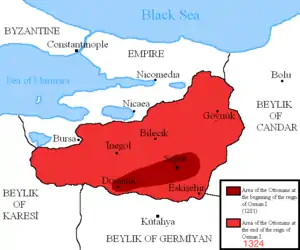
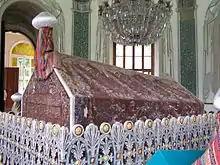
Ottoman historiography depicts Osman as a semi-holy person.[60]
It is known that among the Turkoman tribes, the tribe or part of it was named after its leader. The fact that the Kayi tribe became known by the name of Osman, suggests that the tribe became powerful because of his excellent leadership.[61] Orientalist R. Rakhmanaliev writes that the historical role of Osman was that of a tribal leader, who enjoyed enormous success in uniting his people around him.[62]
The activities and personality of Osman as the founder of the state and dynasty are highly appreciated by historians of both the past and the present. The state and the dynasty of rulers are named after him. The population of the state was called Ottomans (Osmanlilar) until the beginning of the 20th century, that is until the collapse of the Ottoman Empire. Historian F. Uspensky notes that Osman relied not only on force, but also cunningness.[63] Historian and writer Lord Kinross writes that Osman was a wise, patient ruler, whom people sincerely respected and were ready to serve him faithfully. He had a natural sense of superiority, but he never sought to assert himself with the help of power, and therefore he was respected not only by those who were equal in position, but also those who exceeded his abilities on the battlefield or on wisdom. Osman did not arouse feelings of rivalry in his people - only loyalty.[64] Herbert Gibbons believed that Osman was "great enough to exploit masterful people".[65]
According Cemal Kafadar, Osman for the Ottomans was the same as Romulus for the Romans.[66]
Death

According to the sources that say Osman lived to hear of the fall of Bursa, Orhan rushed back to Söğüt to inform his father of his great victory. Once he reached it, he was immediately summoned to Osman, who was on his death-bed. Soon after Osman heard the news, he passed away from natural causes. However, Osman managed to name Orhan to be his successor, although the latter was not Osman's first-born. Yet the dead Emir believed that Orhan better fits to rule compared with his elder half-brother Alâeddin, who was more passive and pious than Orhan.[67] As for the exact cause of Osman's death, it is well-known that he suffered from gout for several years, which seemingly caused his eventual death. This is confirmed by what Aşıkpaşazade mentioned in Tevarih-i Âl-i Osman when he talked about the late period of Osman's life, saying: “Osman had a bad foot from which he experienced severe pain”. It is noted that Aşıkpaşazade used a similar expression when he talked about the death of Sultan Mehmed the Conqueror: “The cause of his death was the issue in his feet”. It is now known that gout is a genetic disease in the Ottoman dynasty, and many sultans suffered from it.[68]
The exact date of Osman's death is debatable. It is said that he died on 21 Ramaḍān 726 AH / 21 August 1326 CE at 70 years old. The 15th century Ottoman Historian Rouhi Çelebi, who wrote down the history of the Ottoman Empire until 1481 CE, indicates that Osman died in 1320. However, Uruç adiloğlu, another Ottoman historian who lived during the time of Sultans Mehmed the Conqueror and Bayezid II up until 1502 CE, says that Osman died in 1327 CE. Contemporary Turkish historian Necdet Sakaoğlu states that, despite the absence of documents mentioning Osman's name after the year 1320 CE, there are documents confirming Orhan's ascension to the throne in 1324 CE. Based on this, Osman's death might have occurred in the previous year.[27][68] It is also certain that Osman's death was three or four months after the death of his father-in-law, Sheikh Edebali, and two months after the death of his wife, Malhun Hatun, because it is known that Osman buried the two in Bilecik.
Once Osman died, Orhan ordered the transfer of his body to Bursa, his new capital. Thus, Osman's body was laid there to rest.[69] His grave is located today in the neighbourhood of Tophane. The reason behind the transferring Osman's body was due to a will Osman did tell his son about during the early years of besieging Bursa: “My Son, when I die, bury me under that silver dome in Bursa”. However, Osman's current tomb dates back to the time of Sultan ʻAbdü'l-ʻAzīz (1861 - 1876 CE), because the first tomb was completely destroyed in a severe earthquake that struck the region in 1855 CE, it was rebuilt by the aforementioned Sultan. Sultan Abdü’l-Ḥamīd II (1876 - 1909 CE) also constructed a shrine in Söğüt where Osman was buried for a while before he was moved to Bursa.[68]
According to some sources, Osman left a written will to his son Orhan instructing him to move on with conquests and jihad against the Byzantines, that he abides by the teachings of Islam, accompany the ʿUlamāʾ, amend his parish, and dedicates himself to spread the word of Islam.[70][71]
Legacy
Osman is considered the founder of the Ottoman dynasty, He started an imperial line that will expand to include thirty-five sultans, who ruled one of the largest and mightiest Empires in history. The Ottoman empire will last till 1918 CE, where it collapsed alongside the other Central Powers, after their defeat in the First World War. Osman is often referred to as the 1st in the line of Ottoman Sultans, although he himself never carried this title in his life, and was instead called “Bey” or “Emir”. One endowment written in Persian and dating back to 1324 CE, indicates that Osman was given the titles Muḥiuddin (Reviver of the faith) and Fakhruddin (Pride of the faith).[72]
Osman's descendants are distributed today in several American, European and Arab countries after the royal Ottoman family was expelled from Turkey in 1924 CE shortly after the declaration of the Republic, by Mustafa Kemal Atatürk.[73] Eventually, several family members returned to Turkey, after the Turkish government allowed the females to return in 1951 CE.[73] However, male descendants had to wait until 1973 CE to be able to enter Turkey again.[74] Other members remained in the countries where their ancestors had sought refuge, such as England, France, the United States, Egypt, Saudi Arabia, among others. Osman's descendants are known today as the Osmanoğlu (son of Osman) family.
Osman's best-known relic is his Sword, which was used during the coronation ceremony of the Ottoman Sultans,[75] since Sultan Murad II.[76] It is said that this sword passed to Osman from his mentor and father-in-law Sheikh Edebali, who gritted him with the “sword of Islam”.[77]
In popular culture
Osman has been portrayed in the Turkish television series Kuruluş/Osmancık (1988), adapted from a novel by the same name,[78] Dirilis: Ertugrul (2014-2019) and Kuruluş: Osman (2019-Present).
References
![]() This article incorporates text by Wikiversity editors available under the CC BY-SA 3.0 license.
This article incorporates text by Wikiversity editors available under the CC BY-SA 3.0 license.
- Eugenia Kermeli (2009). "Osman I". In Ágoston, Gábor; Bruce Masters (eds.). Encyclopedia of the Ottoman Empire. p. 444.
Reliable information regarding Osman is scarce. His birth date is unknown and his symbolic significance as the father of the dynasty has encouraged the development of mythic tales regarding the ruler's life and origins, however, historians agree that before 1300, Osman was simply one among a number of Turkoman tribal leaders operating in the Sakarya region.
- Rhoads Murphey (2008). Exploring Ottoman Sovereignty: Tradition, Image, and Practice in the Ottoman Imperial Household, 1400-1800. London: Continuum. p. 24. ISBN 978-1-84725-220-3.
A reasonable, plausible and, among its peers, probably most reliable account of the early career of Osman by the paragon of Ottoman historians, Kemal Paşa-zade (1468-1534), identifies the hijri year 652 (21 February 1254 to 9 February 1255) as the date of Osman's birth.
- Cemal Kafadar (1995). Between Two Worlds: The Construction of the Ottoman State. p. 16.
By the time of Osman's death (1323 or 1324)...
- Ahmed Akgündüz; Said Öztürk (2011). Ottoman History - Misperceptions and Truths. IUR Press. p. 35. ISBN 978-90-90-26108-9. Retrieved 28 December 2019.
- Heath W. Lowry (2003). The Nature of the Early Ottoman State. Albany: SUNY Press. p. 153. ISBN 978-0-7914-8726-6.
- "Osman I". Encyclopedia Britannica. Osman I, also called Osman Gazi, (born c. 1258—died 1324 or 1326), ruler of a Turkmen principality in northwestern Anatolia who is regarded as the founder of the Ottoman Turkish state.
- The Ottoman Empire, 1700-1999, Donald Quataert, page 4, 2005
- Cemal Kafadar (1995). Between Two Worlds: The Construction of the Ottoman State. p. xii.
There is still not one authentic written document known from the time of ʿOsmān, and there are not many from the fourteenth century altogether.
- Cemal Kafadar (1995). Between Two Worlds: The Construction of the Ottoman State. p. 93.
- Caroline Finkel (2005). Osman's Dream: The Story of the Ottoman Empire, 1300-1923. Basic Books. p. 6. ISBN 978-0-465-02396-7.
Modern historians attempt to sift historical fact from the myths contained in the later stories in which the Ottoman chroniclers accounted for the origins of the dynasty[.]
- Colin Imber (1991). Elizabeth Zachariadou (ed.). The Ottoman Emirate (1300-1389). Rethymnon: Crete University Press. p. 75.
Almost all the traditional tales about Osman Gazi are fictitious. The best thing a modern historian can do is to admit frankly that the earliest history of the Ottomans is a black hole. Any attempt to fill this hole will result simply in more fables.
-
Cemal Kafadar (1995). Between Two Worlds: The Construction of the Ottoman State. p. 122.
That they hailed from the Kayı branch of the Oğuz confederacy seems to be a creative "rediscovery" in the genealogical concoction of the fifteenth century. It is missing not only in Ahmedi but also, and more importantly, in the Yahşi Fakih-Aşıkpaşazade narrative, which gives its own version of an elaborate genealogical family tree going back to Noah. If there was a particularly significant claim to Kayı lineage, it is hard to imagine that Yahşi Fakih would not have heard of it.
- Heath Lowry (2003). The Nature of the Early Ottoman State. SUNY Press. p. 78. ISBN 0-7914-5636-6.
Based on these charters, all of which were drawn up between 1324 and 1360 (almost one hundred fifty years prior to the emergence of the Ottoman dynastic myth identifying them as members of the Kayı branch of the Oguz federation of Turkish tribes), we may posit that...
- Rudi Paul Lindner (1983). Nomads and Ottomans in Medieval Anatolia. Indiana University Press. p. 10.
In fact, no matter how one were to try, the sources simply do not allow the recovery of a family tree linking the antecedents of Osman to the Kayı of the Oğuz tribe.
- Heath Lowry (2003). The Nature of the Early Ottoman State. SUNY Press. p. 78. ISBN 0-7914-5636-6.
- Kafadar, Cemal (1995). Between Two Worlds: The Construction of the Ottoman State. p. 124.
- Ahmet Yaşar Ocak, (2000), Osmanli Devleti'nin kuruluşu: efsaneler ve gerçekler, p. 45 (in Turkish)
- Kenje Kara, Daniel Prior, (2004), Archivum Ottomanicum, Volume 22, p. 140
- Hōca Efendi, Saʿd al-Dīn b. Ḥasan (1863). Tâcü't-Tevârih [The Crown of Histories] (in Ottoman Turkish). Istanbul: Matbaa-i Âmire. pp. 13–15.
- Öztuna, Yılmaz (1988). Mawsūʻat tārīkh al-Imbarāṭūrīyah al-ʻUthmānīyah al-siyāsī wa-al-ʻaskarī wa-al-ḥaḍārī [Encyclopedia of the political, military and cultural history of the Ottoman Empire] (PDF) (in Arabic). Vol. I. Translated by Salman, Adnan Mahmud (1st ed.). Istanbul: Faisal Finance Institution. pp. 83–84.
- Farīd, Muḥammad (2006). Tārīkh al-Dawlah al-ʻAlīyah al-ʻUthmānīyah [History of the Exalted Ottoman State] (in Arabic) (10th ed.). Beirut: Dar al-Nafa'is. pp. 115–116. Archived from the original on 9 May 2019.
- al-Qaramani, Ahmed bin Yusuf bin Ahmed (1985). Tārīkh salāṭīn Āl ʻUthmān [History of the Ottoman Sultans] (in Arabic) (1st ed.). Damascus: Dār al-baṣāʼir. pp. 9–10.
- Shaw, Stanford (1976). History of the Ottoman Empire and Modern Turkey (illustrated, reprinted ed.). Cambridge: Cambridge University Press. pp. 13–14. ISBN 9780521291637.
- Ṭaqqūsh, Muḥammad Suhayl (2013). Tārīkh al-ʻuthmānīyīn min qiyām al-Dawlah ilá al-inqilāb ʻalá al-khilāfah [History of the Ottomans: from the rise of the Empire to the coup against the caliphate] (PDF) (in Arabic) (3rd ed.). Beirut: Dar al-Nafa'is. p. 92. ISBN 9789953184432. Archived from the original (PDF) on 28 April 2019. Retrieved 28 April 2019.
- Armağan, Mustafa (2014). al-tārīkh al-sirrī lil-Imbarāṭūrīyah al-ʻUthmānīyah; Jawānib ghayr Maʻrūfa min ḥayāt Salāṭīn Banī ʻUthmān [The Secret History of the Ottoman Empire: Unrecognized Aspects of the Life of the Ottoman Sultans] (in Arabic). Translated by Hamza, Mustafa (1st ed.). Beirut: al-Dār al-ʻArabīyah lil-ʻUlūm Nāshirūn. p. 11. ISBN 9786140111226.
- Murphey, Rhoads (2008). Exploring Ottoman Sovereignty: Tradition, Image, and Practice in the Ottoman Imperial Household, 1400-1800. London: Continuum. p. 24. ISBN 978-1-84725-220-3.
- Sakaoğlu, Necdet (1999). Yaşamları ve Yapıtlarıyla Osmanlılar Ansiklopedisi, C.2 [Encyclopedia of the Lives and Works of the Ottomans] (in Turkish). Yapı Kredi Kültür Sanat Yayıncılık. pp. 392–395. ISBN 9789750800719.
- Zachariadou, Elizabeth A. (1997). Osmanlı Beyliği, 1300-1389 [Ottoman Beylik, 1300 - 1389] (in Turkish). İstanbul: Türkiye Ekonomik ve Toplumsal Tarih Vakfı. p. 150. ISBN 9789753330671.
- Ḥallāq, Ḥassān (2000). Tārīkh al-shuʻūb al-Islāmīyah al-ḥadīth wa-al-muʻạṣir [Modern and Contemporary History of the Muslim peoples] (in Arabic) (1st ed.). Beirut: Dar al-nahḍah al-ʻArabīyah. pp. 16–17. Archived from the original on 19 March 2020. Retrieved 23 December 2019.
- Sakaoğlu, Necdet (1999). Yaşamları ve Yapıtlarıyla Osmanlılar Ansiklopedisi, C.2 [Encyclopedia of the Lives and Works of the Ottomans] (in Turkish). Yapı Kredi Kültür Sanat Yayıncılık. pp. 392–395. ISBN 9789750800719.
- Öztuna, Yılmaz (1988). Mawsūʻat tārīkh al-Imbarāṭūrīyah al-ʻUthmānīyah al-siyāsī wa-al-ʻaskarī wa-al-ḥaḍārī [Encyclopedia of the political, military and cultural history of the Ottoman Empire] (PDF) (in Arabic). Vol. I. Translated by Salman, Adnan Mahmud (1st ed.). Istanbul: Faisal Finance Institution. pp. 83–84.
- Fleet, Kate. "The rise of the Ottomans". The New Cambridge History of Islam. Vol. 2: The Western Islamic World, Eleventh to Eighteenth Centuries. Cambridge: Cambridge University Press. p. 313. ISBN 9780521839570.
The origins of the Ottomans are obscure. According to legend, largely invented later as part of the process of legitimising Ottoman rule and providing the Ottomans with a suitably august past, it was the Saljuq ruler ʿAlāʾ al-Dīn who bestowed rule on the Ottomans.
- Ibn Iyās, Muhammad (1992). Badāʼiʻ al-zuhūr fī waqāʼiʻ al-duhūr [Flowers in the Chronicles of the Ages] (PDF) (in Arabic). 5th Vol. (1st ed.). Beirut: Dar al-fikr al-Lubnānī. pp. 364–365. Archived from the original (PDF) on 15 December 2019.
- Caroline Finkel (2005). Osman's Dream: The Story of the Ottoman Empire, 1300-1923. Basic Books. p. 12.
Beyond the likelihood that the first Ottoman sultan was a historical figure, a Turcoman Muslim marcher-lord of the Byzantine frontier in north-west Anatolia whose father may have been called Ertuğrul, there is little other biographical information about Osman.
- Stanford Shaw, History of the Ottoman Empire and Modern Turkey (Cambridge: University Press, 1976), vol. 1 ISBN 9780521291637, p. 13
- Kate Fleet (2010). "The rise of the Ottomans". In Fierro, Maribel (ed.). The New Cambridge History of Islam, Volume 2: The Western Islamic World, Eleventh to Eighteenth Centuries. Cambridge: Cambridge University Press. p. 313. ISBN 978-0-521-83957-0.
The origins of the Ottomans are obscure. According to legend, largely invented later as part of the process of legitimising Ottoman rule and providing the Ottomans with a suitably august past, it was the Saljuq ruler ʿAlāʾ al-Dīn who bestowed rule on the Ottomans.
- Colin Imber (2009). The Ottoman Empire, 1300-1650: The Structure of Power (2 ed.). New York: Palgrave Macmillan. p. 8.
- Cemal Kafadar (1995). Between Two Worlds: The Construction of the Ottoman State. p. 129.
Of [military undertakings] we know nothing with certainty until the Battle of Bapheus, Osman's triumphant confrontation with a Byzantine force in 1301 (or 1302), which is the first datable incident in his life.
- Cemal Kafadar (1995). Between Two Worlds: The Construction of the Ottoman State. p. 129.
- Shaw, Ottoman Empire, p. 14
- Kermeli, Eugenia (2009). "Osman I". In Ágoston, Gábor; Bruce Masters (eds.). Encyclopedia of the Ottoman Empire. p. 445.
Apart from these chronicles, there are later sources that begin to establish Osman as a mythic figure. From the 16th century onward a number of dynastic myths are used by Ottoman and Western authors, endowing the founder of the dynasty with more exalted origins. Among these is recounted the famous “dream of Osman” which is supposed to have taken place while he was a guest in the house of a sheikh, Edebali. [...] This highly symbolic narrative should be understood, however, as an example of eschatological mythology required by the subsequent success of the Ottoman emirate to surround the founder of the dynasty with supernatural vision, providential success, and an illustrious genealogy.
- Colin Imber (1987). "The Ottoman Dynastic Myth". Turcica. 19: 7–27. doi:10.2143/TURC.19.0.2014268.
The attraction of Aşıkpasazade's story was not only that it furnished an episode proving that God had bestowed rulership on the Ottomans, but also that it provided, side by side with the physical descent from Oguz Khan, a spiritual descent. [...] Hence the physical union of Osman with a saint's daughter gave the dynasty a spiritual legitimacy and became, after the 1480s, an integral feature of dynastic mythology.
- Colin Imber (1987). "The Ottoman Dynastic Myth". Turcica. 19: 7–27. doi:10.2143/TURC.19.0.2014268.
- Caroline Finkel (2005). Osman's Dream: The Story of the Ottoman Empire, 1300-1923. Basic Books. p. 2., citing Rudi P. Lindner (1983). Nomads and Ottomans in Medieval Anatolia. Bloomington: Indiana University Press. p. 37. ISBN 0-933070-12-8.
- Caroline Finkel (13 February 2006). Osman's Dream: The Story of the Ottoman Empire, 1300-1923. Basic Books. p. 2. ISBN 978-0-465-02396-7.
First communicated in this form in the later fifteenth century, a century and a half after Osman's death in about 1323, this dream became one of the most resilient founding myths of the empire
- Cemal Kafadar (1995). Between Two Worlds: The Construction of the Ottoman State. pp. 132–3.
- Dimitri Korobeĭnikov (2014). Byzantium and the Turks in the Thirteenth Century. Oxford University Press. p. 284. ISBN 978-01-98-70826-1. Retrieved 12 August 2020.
- Ahmed Akgündüz; Said Öztürk (2011). Ottoman History - Misperceptions and Truths. IUR Press. p. 43. ISBN 978-90-90-26108-9. Retrieved 12 August 2020.
- Rudi Paul Lindner (2007). Explorations in Ottoman Prehistory. University of Michigan Press. p. 87. ISBN 9780472095070. Retrieved 12 August 2020.
- Steven Runciman, The Fall of Constantinople 1453 (Cambridge: University Press, 1969) p. 32
- Runciman, The Fall of Constantinople, p. 33
- "Osman I". Encyclopedia Britannica.
- Cemal Kafadar (1995). Between Two Worlds: The Construction of the Ottoman State. pp. 10, 37.
- Colin Imber, (2002), The Ottoman Empire, 1300-1650, p. 95
- Cemal Kafadar (1995). Between Two Worlds: The Construction of the Ottoman State. p. 105.
- Caroline Finkel (13 February 2006). Osman's Dream: The Story of the Ottoman Empire, 1300-1923. Basic Books. p. 6. ISBN 978-0-465-02396-7.
Modern historians attempt to sift historical fact from the myths contained in the later stories in which the Ottoman chroniclers accounted for the origins of the dynasty
- Caroline Finkel (13 February 2006). Osman's Dream: The Story of the Ottoman Empire, 1300-1923. Basic Books. p. 6. ISBN 978-0-465-02396-7.
- Cemal Kafadar (1995). Between Two Worlds: The Construction of the Ottoman State. p. 105.
- Cemal Kafadar (1995). Between Two Worlds: The Construction of the Ottoman State. pp. 107–8.
- Leslie Pierce (1993). The Imperial Harem: Women and Sovereignty in the Ottoman Empire. London: Oxford University Press. p. 33. ISBN 9780195086775.
- Duducu, Jem (15 January 2018). The Sultans: The Rise and Fall of the Ottoman Rulers and Their World: A 600-Year History. Amberley Publishing. ISBN 9781445668611.
- Halil Inalcik, (1973), The Ottoman Empire: The Classical Age, 1300–1600 (The Ottoman Empire), p. 204-205
- Lowry, Heath (2003). The Nature of the Early Ottoman State. SUNY Press. p. 153.
- Lowry, Heath (2003). The Nature of the Early Ottoman State. SUNY Press. p. 73.
- Ertuğrul Gazi ve Halime Sultan Türbesi
- Frederick William Hasluck, [First published 1929], "XLVI. The Girding of the Sultan", in Margaret Hasluck, Christianity and Islam Under the Sultans II, pp. 604–622. ISBN 978-1-4067-5887-0
- Frank R. C. Bagley, The Last Great Muslim Empires (Leiden: Brill, 1969), p. 2 ISBN 978-90-04-02104-4
- "Girding on the Sword of Osman" (PDF). The New York Times. 18 September 1876. p. 2. ISSN 0362-4331. Retrieved 19 April 2009.
- Ihsanoglu, E. "History of the Ottoman state, society and civilization: in 2 volumes"; translated from Turkish by Feonova, ed. by M.S. Meyer; Eastern Literature, 2006. V.1. p. 6; ISBN 5-02-018511-6.
- Ihsanoglu, E. "History of the Ottoman state, society and civilization: in 2 volumes"; Translation from Turkish by V.B.Feonova, ed. by M.S.Meyer; Eastern Literature, 2006. V. 1; p. 6; ISBN 5-02-018511-6.
- R.Rakhmanaliev. "Empire of the Turks. Great civilization. Turkic peoples in World History since the 10th century B.C. to the 20th century". Ripol Classic, 2008. ISBN 5386008471, 9785386008475.
- Uspensky, F. "History of the Byzantine Empire: XI-XV centuries. Eastern question". Moscow, Mysl', 1996. ISBN 524400882X, 9785244008821.
- Kinross, Lord. "The Ottoman Centuries. The Rise and Fall of the Turkish Empire". Harper Collins, 1979.
- Gibbons, Herbert Adams. "The Foundation of the Ottoman Empire: A History of the Osmanlis Up To the Death of Bayezid I 1300-1403". — Routledge, 2013. p. 27. ISBN 1135029822, 9781135029821.
- Kafadar, Cemal. "Between Two Worlds: The Construction of the Ottoman State". University of California Press, 1995. p. 1. ISBN 0520206002, 9780520206007
- Farīd, Muḥammad (2006). Tārīkh al-Dawlah al-ʻAlīyah al-ʻUthmānīyah [History of the Exalted Ottoman State] (in Arabic) (10th ed.). Beirut: Dar al-Nafa'is. pp. 120–122. Archived from the original on 9 May 2019.
- Armağan, Mustafa (2014). al-tārīkh al-sirrī lil-Imbarāṭūrīyah al-ʻUthmānīyah; Jawānib ghayr Maʻrūfa min ḥayāt Salāṭīn Banī ʻUthmān [The Secret History of the Ottoman Empire: Unrecognized Aspects of the Life of the Ottoman Sultans] (in Arabic). Translated by Hamza, Mustafa (1st ed.). Beirut: al-Dār al-ʻArabīyah lil-ʻUlūm Nāshirūn. pp. 11–17. ISBN 9786140111226.
- Sarhank, Ismaʻīl (1988). Tārīkh al-Dawlah al-ʻUthmānīyah [History of the Ottoman Empire] (in Arabic). Beirut: Dar al-Fikr al-Ḥadīth. p. 14.
- Abū Ghunaymah, Ziyād (1983). Jawānib Muḍīʼah fī tārīkh al-ʻUthmānīyīn al-Atrāk [Luminous aspects of the history of the Ottoman Turks] (in Arabic) (1st ed.). Amman: Dar al-Furqān li al-nashr wa al-tawzīʻ. pp. 21–22.
- Ḥarb, Muḥammad (1994). al-Uthmānīyūn fi al-Tārīkh wa al-Ḥaḍārah [The Ottomans in history and civilization] (in Arabic). Cairo: Egyptian Center for Ottoman Studies and Turkish World Researches. p. 12. Retrieved 22 April 2020.
- Öztuna, Yılmaz (1988). Mawsūʻat tārīkh al-Imbarāṭūrīyah al-ʻUthmānīyah al-siyāsī wa-al-ʻaskarī wa-al-ḥaḍārī [Encyclopedia of the political, military and cultural history of the Ottoman Empire] (PDF) (in Arabic). Vol. I. Translated by Salman, Adnan Mahmud (1st ed.). Istanbul: Faisal Finance Institution. p. 91.
- Brookes, Douglas (2008). The concubine, the princess, and the teacher: voices from the Ottoman harem. University of Texas Press. pp. 278, 285. ISBN 9780292783355. Retrieved 14 April 2011.
- Opfell, Olga (2001). Royalty who wait: the 21 heads of formerly regnant houses of Europe. McFarland. pp. 146, 151. ISBN 9780786450572. Retrieved 14 April 2011.
- Hasluck, Frederick William (2007) [First published 1929]. "XLVI. The Girding of the Sultan". In Hasluck, Margaret (ed.). Christianity and Islam Under the Sultans. Vol. II. READ BOOKS. pp. 604–622. ISBN 978-1-4067-5887-0. Retrieved 2 May 2009.
- Topbaş, Osman Nuri (2016). al-ʻUthmānīyūn: rijāluhum al-ʻiẓām wa muʼassasātihim al-shāmikhah [The Ottomans: their great men and their majestic institutions] (PDF) (in Arabic). Translated by Muḥammad, Ḥarb (1st ed.). Istanbul: Dar al-arqam. p. 95. ISBN 9789944835251. Archived from the original (PDF) on 17 April 2018. Retrieved 13 May 2019.
- Bagley, Frank R. C. (1969). The Last Great Muslim Empires. Leiden: BRILL. p. 2. ISBN 978-90-04-02104-4. OCLC 310742207. Retrieved 19 April 2009.
- KUTAY, UĞUR (10 February 2020). "Osmancık'tan ve Osman'a". BirGün (in Turkish). Retrieved 12 June 2020.
Bibliography
- Finkel, Caroline (2005). Osman's Dream: The Story of the Ottoman Empire, 1300-1923. New York: Basic Books. ISBN 978-0-465-02396-7.
- Fleet, Kate (2010). "The rise of the Ottomans". In Maribel Fierro (ed.). The New Cambridge History of Islam. 2. Cambridge: Cambridge University Press. pp. 313–331. ISBN 978-0-521-83957-0.
- Imber, Colin (1987). "The Ottoman Dynastic Myth". Turcica. 19: 7–27. doi:10.2143/TURC.19.0.2014268.
- Imber, Colin (2009). The Ottoman Empire, 1300-1650: The Structure of Power (2 ed.). New York: Palgrave Macmillan. ISBN 978-0-230-57451-9.
- Kafadar, Cemal (1995). Between Two Worlds: The Construction of the Ottoman State. Berkeley: University of California Press. ISBN 978-0-520-20600-7.
- Kermeli, Eugenia (2009). "Osman I". In Ágoston, Gábor; Bruce Masters (eds.). Encyclopedia of the Ottoman Empire. New York: Facts on File. pp. 444–6. ISBN 978-0-8160-6259-1.
- Lindner, Rudi P. (1983). Nomads and Ottomans in Medieval Anatolia. Bloomington: Indiana University Press. ISBN 0-933070-12-8.
- Lowry, Heath (2003). The Nature of the Early Ottoman State. Albany: SUNY Press. ISBN 0-7914-5636-6.
- Murphey, Rhoads (2008). Exploring Ottoman Sovereignty: Tradition, Image, and Practice in the Ottoman Imperial Household, 1400-1800. London: Continuum. ISBN 978-1-84725-220-3.
- Zachariadou, Elizabeth, ed. (1991). The Ottoman Emirate (1300-1389). Rethymnon: Crete University Press.
External links
![]() Media related to Osman I at Wikimedia Commons
Media related to Osman I at Wikimedia Commons
Osman I Born: Unknown Died: 1323/4 | ||
| Regnal titles | ||
|---|---|---|
| New title |
Ottoman Sultan (Bey) c. 1299 – 1323/4 |
Succeeded by Orhan I |
